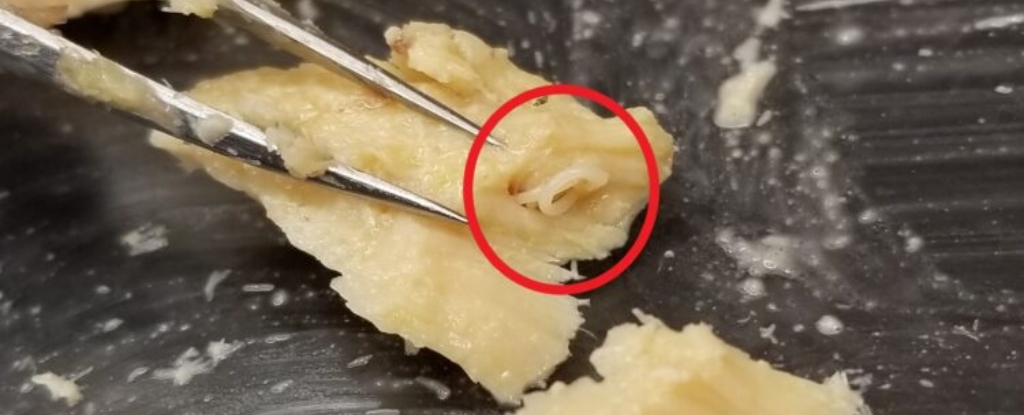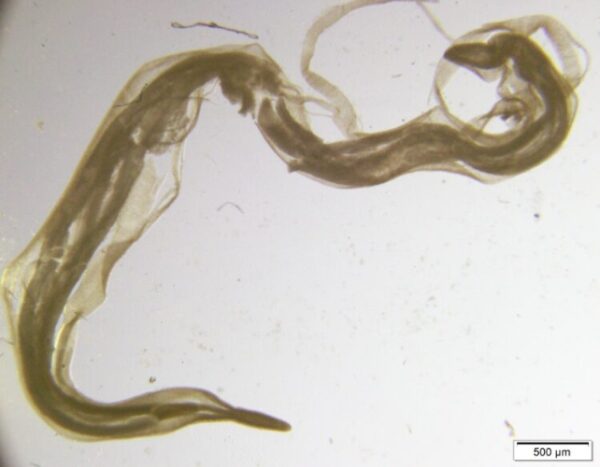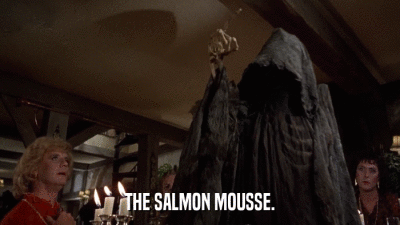
Posted on 03/14/2025 11:17:07 AM PDT by Red Badger

An anisakid worm (circled in red) in a canned salmon fillet. (Natalie Mastick/University of Washington)
=============================================================================================
Canned salmon are the unlikely heroes of an accidental back-of-the-pantry natural history museum, with decades of Alaskan marine ecology preserved in brine and tin.
Parasites can tell us a lot about an ecosystem, because they're usually up in the business of several species. But unless they cause some major problem to humans, historically we haven't paid them much attention.
That's a problem for parasite ecologists, like Natalie Mastick and Chelsea Wood from the University of Washington, who had been searching for a way to retroactively track the effects parasites had on Pacific Northwestern marine mammals.
So when Wood got a call from Seattle's Seafood Products Association, asking if she'd be interested in taking boxes of dusty old expired cans of salmon – dating back to the 1970s – off their hands, her answer was, unequivocally, yes.
The cans had been set aside for decades as part of the association's quality control process, but in the hands of the ecologists, they became an archive of excellently preserved specimens; not of salmon, but of worms.
VIDEO AT LINK..........................
While the idea of worms in your canned fish is a bit stomach-turning, these roughly 0.4-inch (1-centimeter) long marine parasites, anisakids, are harmless to humans when killed during the canning process.
"Everyone assumes that worms in your salmon is a sign that things have gone awry," said Wood when the research was published last year.
"But the anisakid life cycle integrates many components of the food web. I see their presence as a signal that the fish on your plate came from a healthy ecosystem."
Anisakids enter the food web when they are eaten by krill, which in turn are eaten by larger species.
This is how anisakids end up in the salmon, and eventually, the intestines of marine mammals, where the worms complete their life cycle by reproducing. Their eggs are excreted into the ocean by the mammal, and the cycle begins again.
"If a host is not present – marine mammals, for example – anisakids can't complete their life cycle and their numbers will drop," said Wood, the paper's senior author.
The 178 tin cans in the 'archive' contained four different salmon species caught in the Gulf of Alaska and Bristol Bay across a 42-year period (1979–2021), including 42 cans of chum (Oncorhynchus keta), 22 coho (Oncorhynchus kisutch), 62 pink (Oncorhynchus gorbuscha), and 52 sockeye (Oncorhynchus nerka).
Although the techniques used to preserve the salmon do not, thankfully, keep the worms in pristine condition, the researchers were able to dissect the filets and calculate the number of worms per gram of salmon.

A highly degraded anisakid found in canned salmon. (Natalie Mastick/University of Washington) They found worms had increased over time in chum and pink salmon, but not in sockeye or coho.
"Seeing their numbers rise over time, as we did with pink and chum salmon, indicates that these parasites were able to find all the right hosts and reproduce," said Mastick, the paper's lead author.
"That could indicate a stable or recovering ecosystem, with enough of the right hosts for anisakids."
But it's harder to explain the stable levels of worms in coho and sockeye, especially since the canning process made it difficult to identify the specific species of anisakid.
"Though we are confident in our identification to the family level, we could not identify the [anisakids] we detected at the species level," the authors write.
"So it is possible that parasites of an increasing species tend to infect pink and chum salmon, while parasites of a stable species tend to infect coho and sockeye."
Mastick and colleagues think this novel approach – dusty old cans turned ecological archive – could fuel many more scientific discoveries. It seems they've opened quite a can of worms.
This research was published in Ecology and Evolution.
An earlier version of this article was published in April 2024.
I wish they had offered the cans to me. I could have whipped up some salmon mousse
I’ve got a treasure trove for a budding retroactive parasite ecologist...
Wait! I didn’t have the salmon mousse...
in before the Monty Python refff, oh, nevermind. you win.
Here’s the guy that eats old food ,LOL https://www.youtube.com/@ashens/videos
Amazingly enough, no one has made or even photoshopped a salmon mouse...
It had WORMS in the cans....NOT MOOSE!😄 Silly!
I found a really big worm in a really big clam at a clambake bbq many years ago. Stopped with clams right there.
Crunchy Frog. Am I right in thinking that there is a real frog in there.
When my ex’s aunt was getting ready to hack a newly caught halibut, someone told me to prepare to see live worms. I don’t know if it’s true, or if he was messing with me, but went to another room, anyhow.
Roommate used to work in a kitchen. They used to pour vinegar on salmon steaks to see if they were “good.” Worms would come out en masse when exposed to vinegar. The upshot is that they’re more common in farmed salmon vs. fresh.
I try not open a can of worms. Yet for others, it’s an intellectual feast.
A moose once bit my sister.
I picked up some Greek Yogurt with a best before date of today for a good price. I’ve had some of it. So far so good. I live on the edge sometimes.


🙄😁.............................
They need to check with my X. She keeps food so long that is escapes identification.
From the 70s you say?
There isn’t such a thing as a Spam worm, is there?
(inquiring minds want to know)
Disclaimer: Opinions posted on Free Republic are those of the individual posters and do not necessarily represent the opinion of Free Republic or its management. All materials posted herein are protected by copyright law and the exemption for fair use of copyrighted works.